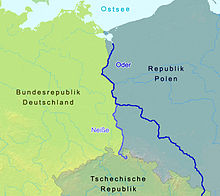
The Partial Test Ban Treaty (PTBT), formally known as the 1963 Treaty Banning Nuclear Weapon Tests in the Atmosphere, in Outer Space and Under Water, prohibited all test detonations of nuclear weapons except for those conducted underground. It is also abbreviated as the Limited Test Ban Treaty (LTBT) and Nuclear Test Ban Treaty (NTBT), though the latter may also refer to the Comprehensive Nuclear-Test-Ban Treaty (CTBT), which succeeded the PTBT for ratifying parties.

The Warsaw Pact (WP), formally the Treaty of Friendship, Cooperation and Mutual Assistance (TFCMA), was a collective defense treaty signed in Warsaw, Poland, between the Soviet Union and seven other Eastern Bloc socialist republics of Central and Eastern Europe in May 1955, during the Cold War. The term "Warsaw Pact" commonly refers to both the treaty itself and its resultant defensive alliance, the Warsaw Treaty Organization (WTO). The Warsaw Pact was the military and economic complement to the Council for Mutual Economic Assistance (Comecon), the regional economic organization for the Eastern Bloc states of Central and Eastern Europe.

World War III, World War 3, WWIII, WW3, or the Third World War are the names given to a hypothetical global conflict subsequent to World War I and World War II. The term has been in use since as early as 1941. Some apply it loosely to limited or more minor conflicts such as the Cold War or the war on terror. In contrast, others assume that such a conflict would surpass prior world wars in both scope and destructive impact.
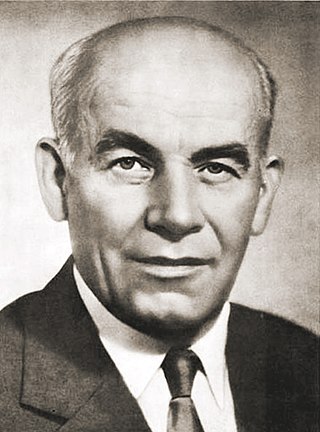
Władysław Gomułka was a Polish Communist politician. He was the de facto leader of post-war Poland from 1947 until 1948, and again from 1956 to 1970.

The Intermediate-Range Nuclear Forces Treaty was an arms control treaty between the United States and the Soviet Union. US President Ronald Reagan and Soviet General Secretary Mikhail Gorbachev signed the treaty on 8 December 1987. The US Senate approved the treaty on 27 May 1988, and Reagan and Gorbachev ratified it on 1 June 1988.

The Treaty on the Final Settlement with Respect to Germany , or the Two Plus Four Agreement , is an international agreement that allowed the reunification of Germany in the early 1990s. It was negotiated in 1990 between the 'two', the Federal Republic of Germany and the German Democratic Republic, in addition to the Four Powers which had occupied Germany at the end of World War II in Europe: France, the Soviet Union, the United Kingdom, and the United States. The treaty supplanted the 1945 Potsdam Agreement: in it, the Four Powers renounced all rights they had held with regard to Germany, allowing for its reunification as a fully sovereign state the following year. Additionally, the two German states agreed to reconfirm the existing border with Poland, accepting that German territory post-reunification would consist only of what was presently administered by West and East Germany—renouncing explicitly any possible claims to the former eastern territories of Germany including East Prussia, most of Silesia, as well as the eastern parts of Brandenburg and Pomerania.

Adam Rapacki was a leading Polish Communist politician and diplomat from 1947 to 1968. He started in the socialist movement but in 1948 joined the Central Committee of the new Polish United Workers' Party (PZPR), and became a member of its Politburo. It had very close ties to the Kremlin. He is best known for his 1957 proposal for the creation of nuclear-free zones in Europe; it was never adopted. He maintained good relations with East Germany while warning against West German expansionism. Piotr Wandycz considers that he was well educated, cosmopolitan, pragmatic, liberal and ambitious, and imbued with a sense of patriotism and belief in cooperation with the left in Western Europe.
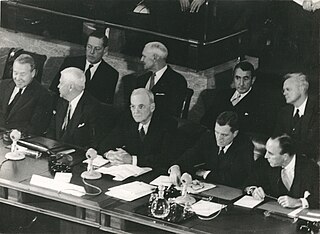
The Geneva Summit of 1955 was a Cold War-era meeting in Geneva, Switzerland. Held on July 18, 1955, it was a meeting of "The Big Four": President Dwight D. Eisenhower of the United States, Prime Minister Anthony Eden of Britain, Premier Nikolai A. Bulganin of the Soviet Union, and Prime Minister Edgar Faure of France. They were accompanied by the foreign ministers of the four powers : John Foster Dulles, Harold Macmillan, Vyacheslav Molotov, and Antoine Pinay. Also in attendance was Nikita Khrushchev, de facto leader of the Soviet Union.
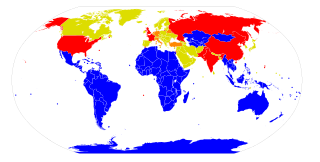
A nuclear-weapon-free zone (NWFZ) is defined by the United Nations as an agreement that a group of states has freely established by treaty or convention that bans the development, manufacturing, control, possession, testing, stationing or transporting of nuclear weapons in a given area, that has mechanisms of verification and control to enforce its obligations, and that is recognized as such by the General Assembly of the United Nations. NWFZs have a similar purpose to, but are distinct from, the Treaty on the Non-Proliferation of Nuclear Weapons to which most countries including five nuclear weapons states are a party. Another term, nuclear-free zone, often means an area that has banned both nuclear power and nuclear weapons, and sometimes nuclear waste and nuclear propulsion, and usually does not mean a UN-acknowledged international treaty.

Seven Days to the River Rhine was a top-secret military simulation exercise developed at least since 1964 by the Warsaw Pact. It depicted the Soviet Bloc's vision of a seven-day nuclear war between NATO and Warsaw Pact forces.

World War III is a 1998 German alternate history television pseudo-documentary, directed by Robert Stone and distributed by ZDF. An English version was also made, which aired on TLC in May 1999. It depicts what might have transpired if, following the overthrow of Mikhail Gorbachev, Soviet troops, under orders from a new hard-line regime, had opened fire on demonstrators in Berlin in the fall of 1989 and precipitated World War III. The film mixes real footage of world leaders and archive footage of combat exercises and news events, with newly shot footage of citizens, soldiers, and political staff.
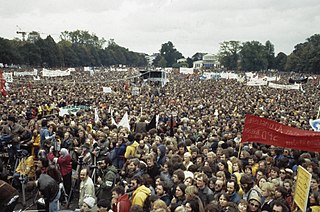
The NATO Double-Track Decision was the decision by NATO from December 12, 1979, to offer the Warsaw Pact a mutual limitation of medium-range ballistic missiles and intermediate-range ballistic missiles. It was combined with a threat by NATO to deploy more medium-range nuclear weapons in Western Europe after the Euromissile Crisis.

Official relations between Poland and the United States on a diplomatic level were initiated in 1919 after Poland had established itself as a republic after 123 years of being under foreign rule from the Partitions of Poland. However, ties with the United States date back to the 17th century, when the Polish–Lithuanian Commonwealth was one of Europe's largest powers, and many Poles immigrated to the Thirteen Colonies. During the American Revolutionary War, the Polish military commanders Tadeusz Kościuszko and Casimir Pułaski contributed greatly to the Patriot cause, with Kościuszko becoming a national hero in America. Since 1989, Polish–American relations have been strong and Poland is one of the chief European allies of the United States, being part of both NATO and the European Union. There is a strong cultural appreciation between the two nations (Polonophilia). According to the US Department of State, Poland remains a "stalwart ally" and "one of strongest Continental partners in fostering security and prosperity, throughout Europe and the world." Poland was also one of four participating countries in the American-led Iraq War coalition in 2003.

Denmark–Poland relations refers to the bilateral relations between Denmark and Poland. Relations between the two countries date back to the Middle Ages, while modern diplomatic relations were established on 8 September 1919. During the 20th century, relations were turbulent but amicable. The two countries moreover maintained a maritime border dispute until 2018 when it was delineated.
The following outline is provided as an overview of and topical guide to the Cold War:

The Mutual and Balanced Force Reductions (MBFR) talks were a series of negotiations held in Vienna between NATO and Warsaw Pact countries between 1973 and 1989.
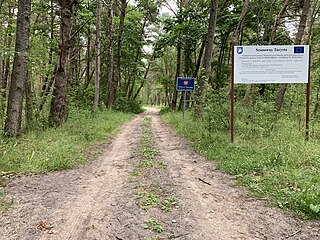
The modern Poland–Russia border is a nearly straight-line division between the Republic of Poland and the Russian Federation exclave Kaliningrad Oblast, a region not connected to the Russian mainland. It is 232 kilometres (144 mi) long. The current location and length of the border was decided in the aftermath of World War II. In 2004, it became part of the boundary of the European Union and the Commonwealth of Independent States.

The Murmansk Initiative was a series of wide-range foreign policy proposals concerning the Arctic region made in a speech by the Secretary-General of the Communist Party of the Soviet Union - Mikhail Gorbachev - on October 1, 1987 in Murmansk, Soviet Union, considered to be a trademark of his foreign policy.
Przemysław Antoni Ogrodziński, also known by his pseudonyms 'Stanisław', 'Dyplomata', and 'Agapit' was a Polish diplomat and activist.
The Berlin Crisis of 1958–1959 was a crisis over the status of West Berlin during the Cold War. It resulted from efforts by Soviet leader Nikita Khrushchev to react strongly against American nuclear warheads located in West Germany, and build up the prestige of the Soviet satellite state of East Germany. American President Dwight D. Eisenhower mobilized NATO opposition. He was strongly supported by German Chancellor Konrad Adenauer, but Great Britain went along reluctantly. There was never any military action. The result was a continuation of the status quo in Berlin, and a move by Eisenhower and Khrushchev toward détente. The Berlin problem had not disappeared, and escalated into a major conflict over building the Berlin Wall in 1961. See Berlin Crisis of 1961.
